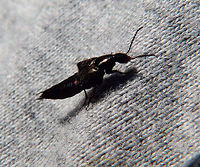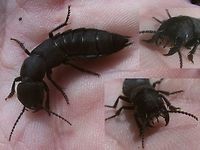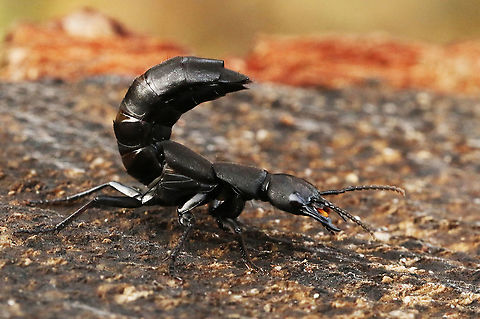![Devil's coach-horse (Ocypus olens) [some of the text below was originally written by Patomarazul as a description with this image<br />
<figure class="photo"><a href="https://www.jungledragon.com/image/43321/rove_beetle.html" title="Rove beetle"><img src="https://s3.amazonaws.com/media.jungledragon.com/images/2298/43321_thumb.jpg?AWSAccessKeyId=05GMT0V3GWVNE7GGM1R2&Expires=1767225610&Signature=rVlAPazlR%2FRZpDnIwwgecuoAcN4%3D" width="200" height="168" alt="Rove beetle De Liereman, Oud-Turnhout, Belgium (Aug, 2015).<br />
It is a small but long-bodied beetle. Its wing covers (elytra) are short covering only its thorax, exposing the abdominal segments. The abdominal musculature is powerful and the abdominal segments are covered with sclerotized plates. Belgium,Coleoptera,Geotagged,Rove beetle,Staphylinidae,Summer" /></a></figure><br />
but that image didn't show the species discussed]<br />
<br />
The "Devil's coach-horse beetle" with a length of 20-30mm is one of the largest Rove beetles in Europe. As with other Rove beetles the wing covers (elytra) are short, covering only its thorax, exposing the abdominal segments. The abdominal musculature is powerful and the abdominal segments are covered with sclerotized plates. It is capable of flight but its wings are rarely used. It is covered with fine black hairs. It is well known for its habit of opening its jaws and raising its long and uncovered abdomen, like a scorpion when threatened. This explains one of its alternative names, the cock-tail beetle. Although it has no sting, it can give a painful bite with its strong pincer-like jaws. It can also emit a foul smelling odour as a defensive, through a white secretion from a pair of glands at the end of its abdomen.<br />
Rove beetles (Staphylinidae) are generally hard to identify. It's a large family with many lookalikes for almost all the common species. A larger Ocypus olens (over 25mm) can be distinguished from most others merely by it's size, but you do need to measure not guestimate, as below 25mm there are many more candidates. Still, even for the larger ones, there are a few lookalikes than can reach the same size - most notably Ocypus tenebricosus and O. pedemontanus that also share some of the distribution area.<br />
Also there is some variance in how some authors delimit the genus Ocypus with some groups such as Tasgius or maybe Pseudocypus being either treated as a subgenus or as a genus in its own right. So, especially for the smaller species of Ocypus these need to be considered as lookalikes too.<br />
The image below has a few more perspectives on this specimen, that helped me identify it:<br />
<figure class="photo"><a href="https://www.jungledragon.com/image/48037/ocypus_olens_-_collage.html" title="Ocypus olens - Collage"><img src="https://s3.amazonaws.com/media.jungledragon.com/images/3043/48037_thumb.jpg?AWSAccessKeyId=05GMT0V3GWVNE7GGM1R2&Expires=1767225610&Signature=IxnyPqCfeFhByyxUKxkTLa%2F9baE%3D" width="200" height="150" alt="Ocypus olens - Collage Some extra perspectives on the Devils coach-horse below:<br />
https://www.jungledragon.com/image/48036/ocypus_olens.html Coleoptera,Devils coach-horse beetle,France,Geotagged,Ocypus,Ocypus olens,Rove beetle,Staphylinidae,Staphylinini" /></a></figure> Coleoptera,Devils coach-horse beetle,France,Geotagged,Ocypus,Ocypus olens,Rove beetle,Staphylinidae,Staphylinini](https://s3.amazonaws.com/media.jungledragon.com/images/3043/48036_medium.jpg?AWSAccessKeyId=05GMT0V3GWVNE7GGM1R2&Expires=1767225610&Signature=Azue4b6XZrUVza%2FYw5w5OEHozxw%3D) PromotedSpecies introCountry intro
PromotedSpecies introCountry intro
Devil's coach-horse (Ocypus olens)
[some of the text below was originally written by Patomarazul as a description with this image

but that image didn't show the species discussed]
The "Devil's coach-horse beetle" with a length of 20-30mm is one of the largest Rove beetles in Europe. As with other Rove beetles the wing covers (elytra) are short, covering only its thorax, exposing the abdominal segments. The abdominal musculature is powerful and the abdominal segments are covered with sclerotized plates. It is capable of flight but its wings are rarely used. It is covered with fine black hairs. It is well known for its habit of opening its jaws and raising its long and uncovered abdomen, like a scorpion when threatened. This explains one of its alternative names, the cock-tail beetle. Although it has no sting, it can give a painful bite with its strong pincer-like jaws. It can also emit a foul smelling odour as a defensive, through a white secretion from a pair of glands at the end of its abdomen.
Rove beetles (Staphylinidae) are generally hard to identify. It's a large family with many lookalikes for almost all the common species. A larger Ocypus olens (over 25mm) can be distinguished from most others merely by it's size, but you do need to measure not guestimate, as below 25mm there are many more candidates. Still, even for the larger ones, there are a few lookalikes than can reach the same size - most notably Ocypus tenebricosus and O. pedemontanus that also share some of the distribution area.
Also there is some variance in how some authors delimit the genus Ocypus with some groups such as Tasgius or maybe Pseudocypus being either treated as a subgenus or as a genus in its own right. So, especially for the smaller species of Ocypus these need to be considered as lookalikes too.
The image below has a few more perspectives on this specimen, that helped me identify it:


The Devil's coach-horse beetle is a species of beetle belonging to the large family of the rove beetles. It was originally included in the genus "Staphylinus" in 1764, and some authors and biologists still use this classification.

comments (3)